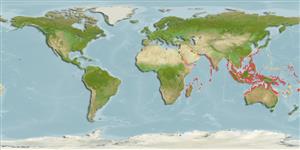>
Gobiiformes (Gobies) >
Gobiidae (Gobies) > Gobiinae
Etymology: Cryptocentrus: Greek, kryptos = hidden + Greek, kentron = sting (Ref. 45335).
Environment: milieu / climate zone / depth range / distribution range
Ecologia
marinhas associadas(os) a recifes; intervalo de profundidade 5 - 20 m (Ref. 11441), usually 5 - 15 m (Ref. 9710). Tropical
Indo-West Pacific: East Africa to Melanesia and the Great Barrier Reef.
Tamanho / Peso / Idade
Maturity: Lm ? range ? - ? cm
Max length : 14.0 cm TL macho/indeterminado; (Ref. 9710)
Descrição breve
Chaves de identificação | Morfologia | Morfometria
Espinhos dorsais (total) : 6 - 7; Raios dorsais moles (total) : 10; Espinhos anais: 1; Raios anais moles: 9. Mostly black with fine pale spotting or white saddles over top of head and back; sometimes yellow (Ref. 30404); further characterized by variable coloration ranging from yellow, entirely blackish, or barred or mottled; dorsal fins unmarked; barred variety with four brown saddles, head with white or bluish streaks, plain dorsal fins, pelvic fins with blue spots, blue stripe on anal fin; saddled variety dark brown color with whitish saddles on top of head and along back; head with small white or blue spots or streaks, pelvic fins with blue spots, blue stripes on anal fins; mottled variety with four diffuse brown bars on side; lower operculum with large brown blotch, head with white to bluish spots, strong mottling on back, anal fin with blue stripes; united pelvic fins, presence of frenum; longitudinal scale series 77-92; absence of scales on head except a few scales dorsally on opercle; greatest depth of body 5.5-5.8 in SL; rounded caudal fin, 3.2-3.8 in SL (Ref. 90102).
Found on sand near patch reefs, usually in 5 m but to at least 15 m (Ref. 9710). Found in burrows with alpheid shrimps (Ref. 2334). Two individuals sometimes share a burrow, and these may be one of each color (Ref. 9360). Occurs in clear coastal and inner reef sand slopes, in small colonies in depth of 6-20 meters (Ref. 48637).
Life cycle and mating behavior
Maturities | Reprodução | Spawnings | Egg(s) | Fecundities | Larvas
Randall, J.E., G.R. Allen and R.C. Steene, 1990. Fishes of the Great Barrier Reef and Coral Sea. University of Hawaii Press, Honolulu, Hawaii. 506 p. (Ref. 2334)
Categoria na Lista Vermelha da IUCN (Ref. 130435)
Ameaça para o homem
Harmless
Utilização humana
Pescarias: espécies comerciais; Aquário: Espécies comerciais
Ferramentas
Relatórios especiais
Descarregue XML
Fontes da internet
Estimates based on models
Preferred temperature (Ref.
123201): 25.4 - 29.3, mean 28.5 °C (based on 2738 cells).
Phylogenetic diversity index (Ref.
82804): PD
50 = 0.5000 [Uniqueness, from 0.5 = low to 2.0 = high].
Bayesian length-weight: a=0.00708 (0.00333 - 0.01504), b=3.09 (2.92 - 3.26), in cm total length, based on LWR estimates for this (Sub)family-body shape (Ref.
93245).
Nível Trófico (Ref.
69278): 3.4 ±0.4 se; based on size and trophs of closest relatives
Resiliência (Ref.
120179): Elevada, tempo mínimo de duplicação da população menor que 15 meses (Preliminary K or Fecundity.).
Fishing Vulnerability (Ref.
59153): Low vulnerability (10 of 100).
Nutrients (Ref.
124155): Calcium = 112 [52, 208] mg/100g; Iron = 0.692 [0.364, 1.320] mg/100g; Protein = 18 [16, 20] %; Omega3 = 0.0853 [, ] g/100g; Selenium = 24.1 [12.0, 51.6] μg/100g; VitaminA = 113 [30, 380] μg/100g; Zinc = 1.81 [1.19, 2.67] mg/100g (wet weight);
